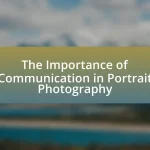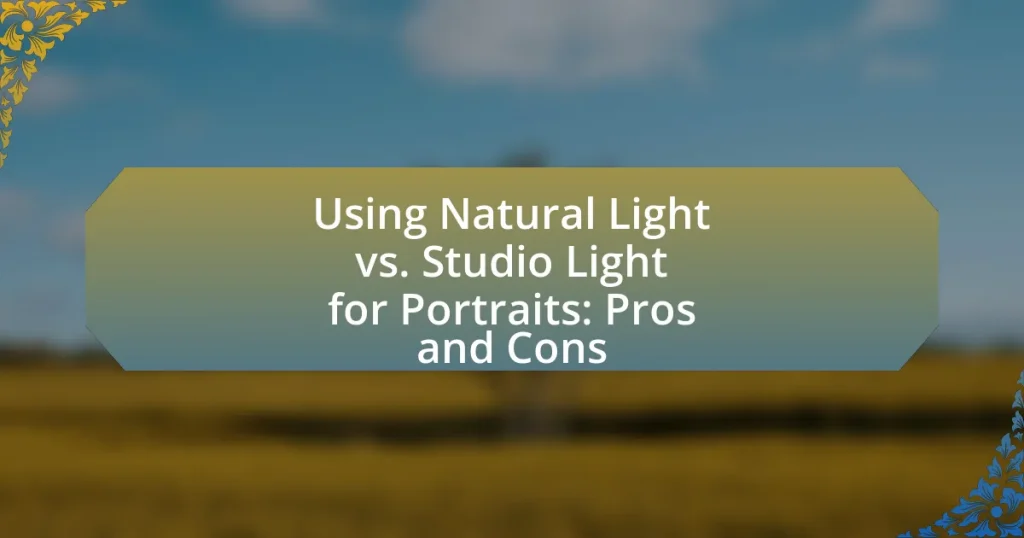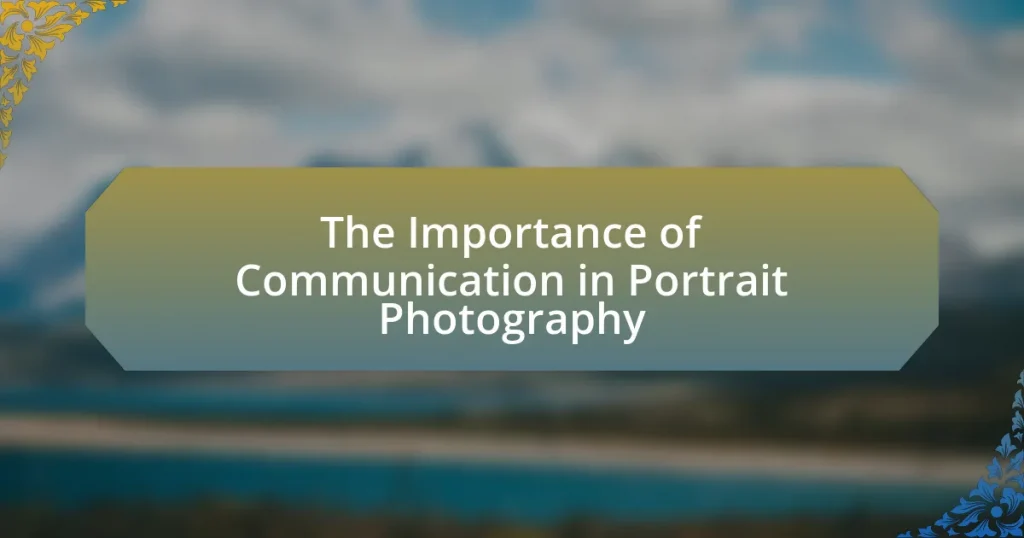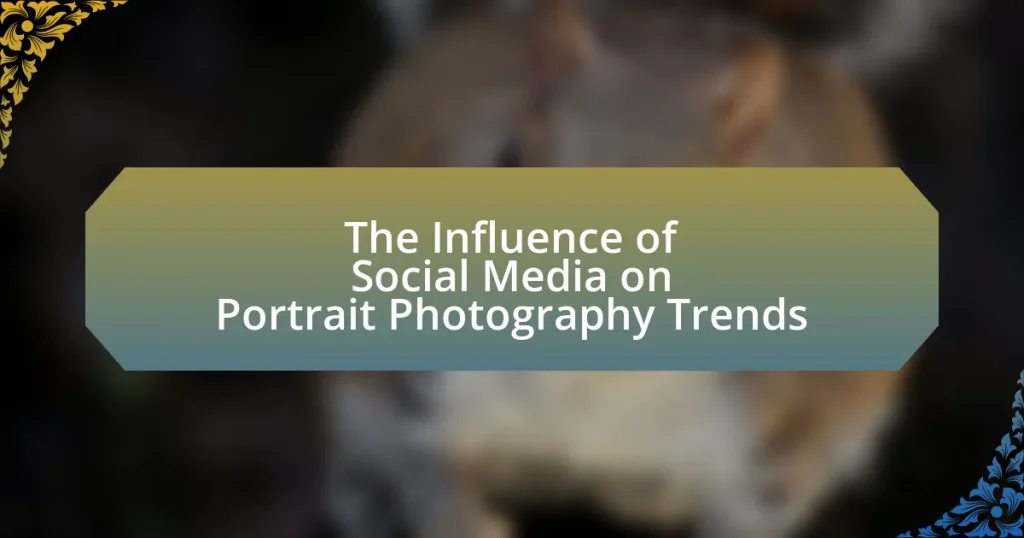The article examines the key differences between natural light and studio light in portrait photography, focusing on their sources, control, and quality. It highlights how natural light varies throughout the day, influencing skin tones and emotional responses, while studio light offers precise control over lighting conditions, allowing for consistent results. The discussion includes the advantages and challenges of both lighting types, such as the unpredictability of natural light and the complexity of studio setups. Additionally, it explores best practices for combining both light sources to enhance portrait quality and achieve desired artistic effects.
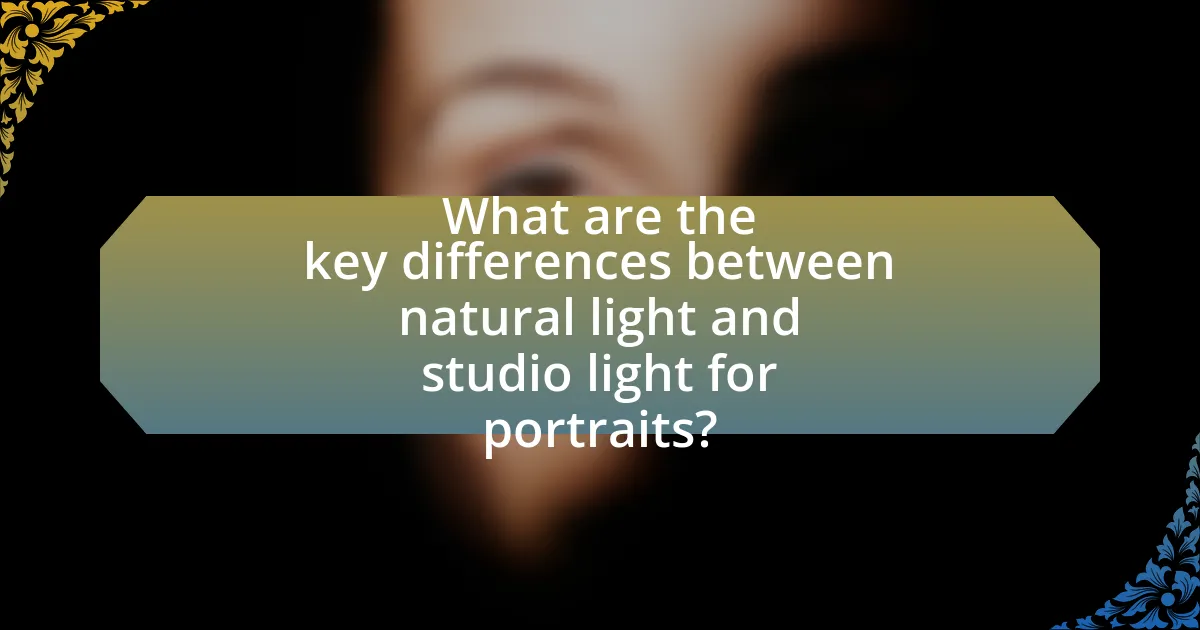
What are the key differences between natural light and studio light for portraits?
Natural light and studio light differ primarily in their source, control, and quality. Natural light is sunlight that varies in intensity and color temperature throughout the day, providing a soft, diffused effect when used during golden hour, while studio light consists of artificial lighting sources like strobes or continuous lights that can be adjusted for brightness and color balance. Studio light allows for greater control over the lighting environment, enabling photographers to create consistent results regardless of external conditions, whereas natural light can be unpredictable and requires adaptability. Additionally, studio light can produce sharper shadows and highlights, while natural light often results in a more flattering, softer appearance on skin tones.
How does natural light influence portrait photography?
Natural light significantly influences portrait photography by creating soft, flattering illumination that enhances skin tones and textures. This type of light varies throughout the day, with golden hour providing warm, diffused light that minimizes harsh shadows, making subjects appear more appealing. Studies show that natural light can evoke emotional responses in viewers, as it often conveys a sense of authenticity and connection. Additionally, natural light is readily available and cost-effective, allowing photographers to capture stunning images without the need for expensive equipment.
What are the characteristics of natural light that affect portraits?
Natural light characteristics that affect portraits include direction, quality, color temperature, and intensity. The direction of natural light influences shadows and highlights on the subject’s face, with front lighting minimizing shadows and side lighting enhancing texture. Quality refers to the softness or hardness of light; soft light, often found during overcast days or in shaded areas, reduces harsh shadows, while hard light creates defined shadows and contrast. Color temperature affects the mood of the portrait; natural light varies from warm tones during sunrise and sunset to cooler tones during midday. Intensity impacts exposure and detail; bright sunlight can lead to overexposure, while lower light levels may require adjustments in camera settings to capture detail effectively. These characteristics collectively shape the overall aesthetic and emotional impact of portrait photography.
How does the time of day impact natural light for photography?
The time of day significantly impacts natural light for photography by altering the quality, direction, and intensity of light. During the golden hour, which occurs shortly after sunrise and before sunset, the light is softer and warmer, creating flattering conditions for portraits. In contrast, midday light is harsher and can produce unflattering shadows, making it less ideal for photography. Studies show that the angle of the sun affects the color temperature, with morning and evening light being more diffused and rich in color, while midday light tends to be cooler and more direct. This variation in natural light throughout the day is crucial for photographers to consider when planning their shoots.
What advantages does studio light offer for portrait photography?
Studio light offers precise control over lighting conditions in portrait photography, allowing photographers to manipulate intensity, direction, and quality of light. This control enables the creation of consistent and flattering lighting that enhances the subject’s features, reduces harsh shadows, and minimizes unflattering reflections. Additionally, studio lights can be adjusted to achieve various effects, such as soft or dramatic lighting, which is essential for artistic expression in portraits. The use of modifiers like softboxes and umbrellas further enhances the quality of light, providing a professional finish that is often difficult to achieve with natural light alone.
What types of studio lighting setups are commonly used?
Commonly used studio lighting setups include three-point lighting, softbox lighting, and ring light setups. Three-point lighting consists of a key light, fill light, and back light, which together create depth and dimension in portraits. Softbox lighting utilizes diffused light sources to produce soft, even illumination, reducing harsh shadows. Ring light setups provide uniform lighting around the subject, often used in beauty and portrait photography for a flattering effect. These setups are widely adopted due to their effectiveness in controlling light and enhancing the quality of images.
How can studio light be manipulated for different effects?
Studio light can be manipulated for different effects by adjusting the intensity, direction, and quality of the light. For instance, increasing the intensity can create a more dramatic look, while softening the light through diffusers can produce a gentle, flattering effect. Additionally, changing the direction of the light can alter shadows and highlights, enhancing facial features or creating depth. Using modifiers like reflectors or grids can further refine the light’s quality, allowing for specific artistic outcomes. These techniques are widely utilized in portrait photography to achieve desired visual styles and emotional impacts.
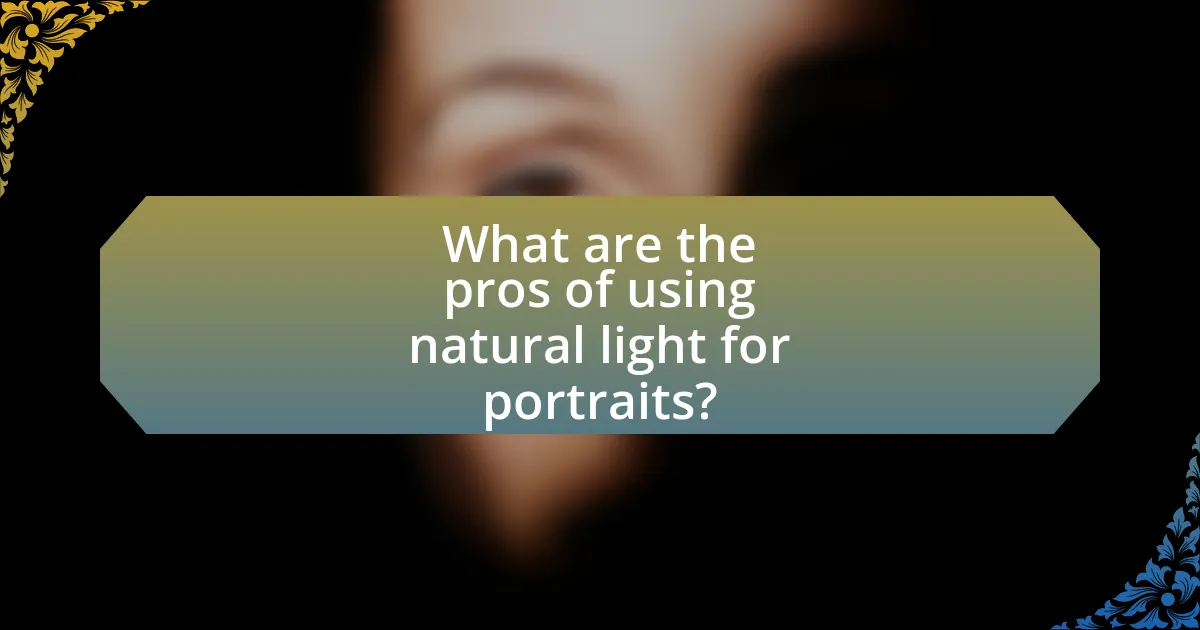
What are the pros of using natural light for portraits?
Using natural light for portraits offers several advantages, including softer lighting, enhanced skin tones, and a more dynamic atmosphere. Natural light creates a flattering, diffused effect that reduces harsh shadows, making subjects appear more appealing. Additionally, it captures the true colors of the environment, resulting in vibrant and realistic skin tones. Studies have shown that natural light can evoke a sense of authenticity and connection in portraits, as it reflects the subject’s surroundings and mood. Furthermore, utilizing natural light is cost-effective, eliminating the need for expensive studio equipment and allowing for greater flexibility in shooting locations.
Why do photographers prefer natural light in certain situations?
Photographers prefer natural light in certain situations because it provides a soft, flattering quality that enhances skin tones and textures. Natural light, especially during golden hour, creates a warm glow that is often more aesthetically pleasing than artificial lighting. Additionally, natural light is readily available and can be easily manipulated by changing the angle or position of the subject, allowing for creative flexibility. Studies have shown that images taken in natural light often exhibit a more authentic and organic feel, which resonates well with viewers.
What are the aesthetic benefits of natural light in portraits?
Natural light enhances portraits by providing soft, flattering illumination that reduces harsh shadows and highlights facial features naturally. This type of lighting creates a more authentic and organic feel, allowing for a greater connection between the subject and viewer. Studies have shown that natural light can improve skin tone representation, making subjects appear more vibrant and lifelike. Additionally, the dynamic quality of natural light changes throughout the day, offering diverse moods and atmospheres that can enrich the storytelling aspect of portrait photography.
How does natural light contribute to a more authentic feel in portraits?
Natural light contributes to a more authentic feel in portraits by creating soft, natural shadows and highlights that enhance the subject’s features. This type of lighting mimics the way the human eye perceives light in everyday life, resulting in a more relatable and genuine representation. Studies have shown that portraits taken in natural light often evoke a sense of warmth and intimacy, which can lead to a stronger emotional connection between the viewer and the subject. Additionally, natural light varies throughout the day, allowing for diverse moods and tones that can further enhance the authenticity of the portrait.
What challenges do photographers face when using natural light?
Photographers face several challenges when using natural light, including variability in lighting conditions, limited control over intensity and direction, and the impact of weather. Natural light changes throughout the day, which can lead to inconsistent exposure and color balance in images. Additionally, photographers often struggle to manipulate the light effectively, as they cannot adjust the sun’s position or intensity like they can with studio lights. Weather conditions, such as clouds or rain, can further complicate outdoor shoots, leading to unexpected changes in lighting that may hinder the desired outcome. These factors collectively make it difficult for photographers to achieve consistent and high-quality results when relying solely on natural light.
How can changing weather conditions affect natural light availability?
Changing weather conditions significantly affect natural light availability by altering the intensity and quality of sunlight. For instance, overcast skies reduce direct sunlight, resulting in softer, diffused light that can enhance portrait photography by minimizing harsh shadows. Conversely, clear skies increase direct sunlight, which can create strong contrasts and sharp shadows, potentially complicating portrait lighting. Additionally, weather phenomena such as rain or snow can further diminish light levels, while atmospheric conditions like humidity can scatter light, affecting its clarity and color temperature. These variations in natural light due to changing weather are crucial for photographers to consider when planning outdoor portrait sessions.
What limitations does natural light impose on shooting locations?
Natural light imposes several limitations on shooting locations, primarily related to time of day, weather conditions, and location accessibility. The quality and direction of natural light change throughout the day, affecting the consistency of lighting; for instance, the golden hour provides soft, warm light, while midday sun can create harsh shadows. Additionally, adverse weather conditions such as overcast skies or rain can diminish light availability, making it challenging to achieve desired exposure levels. Furthermore, certain locations may not be accessible during specific times due to natural light constraints, limiting the options for photographers seeking optimal lighting conditions.
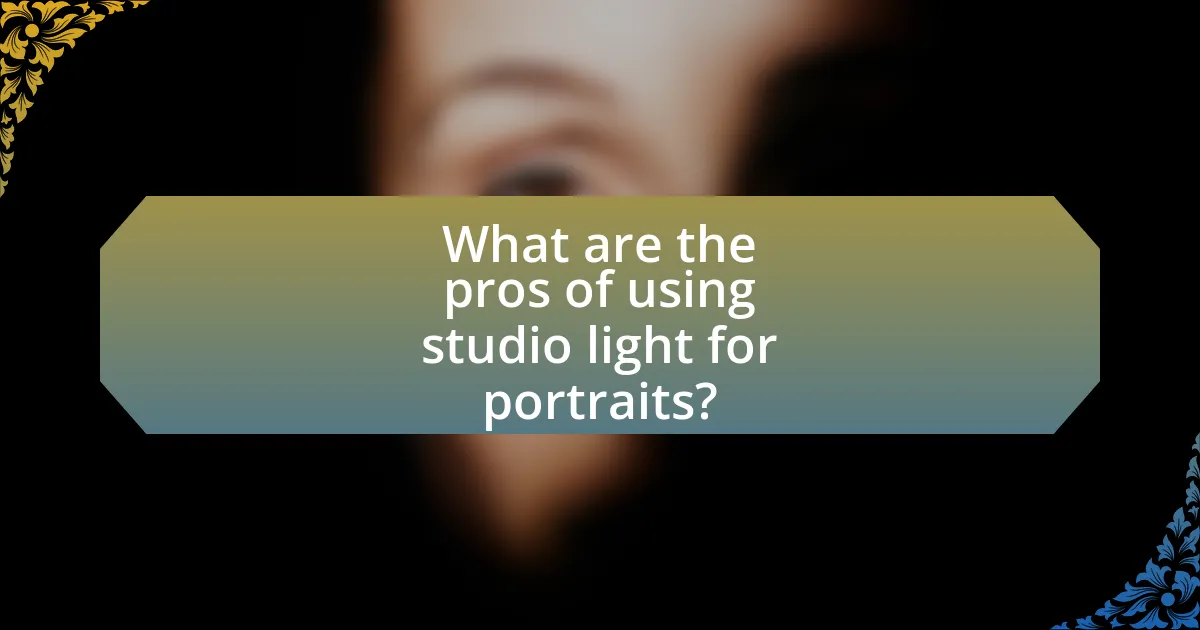
What are the pros of using studio light for portraits?
Using studio light for portraits offers several advantages, including precise control over lighting conditions. This control allows photographers to manipulate shadows, highlights, and overall exposure to achieve the desired aesthetic. Additionally, studio lights provide consistent illumination, which is crucial for maintaining uniformity across a series of shots. The ability to use modifiers, such as softboxes and umbrellas, enhances the quality of light, resulting in softer and more flattering portraits. Furthermore, studio lighting is not dependent on external factors like weather or time of day, enabling photographers to work in a controlled environment at any time. These benefits collectively contribute to higher-quality portrait outcomes.
How does studio light provide consistency in portrait photography?
Studio light provides consistency in portrait photography by delivering controlled illumination that remains uniform across different shooting conditions. This controlled environment allows photographers to replicate the same lighting setup for various sessions, ensuring that the quality and direction of light are consistent. For instance, studio lights can be adjusted for intensity, color temperature, and angle, which helps maintain a cohesive look in a series of portraits. Additionally, the use of softboxes or diffusers can create soft, even lighting that minimizes harsh shadows, further enhancing the consistency of the final images.
What are the benefits of controlled lighting environments?
Controlled lighting environments provide consistent illumination, allowing for precise manipulation of light and shadow in portrait photography. This consistency enhances the ability to achieve desired effects, such as mood and texture, which can be difficult to replicate with natural light due to its variability. Additionally, controlled lighting environments enable photographers to eliminate unwanted shadows and highlights, ensuring that subjects are evenly lit and details are captured accurately. Studies have shown that controlled lighting can improve the overall quality of images, making them more visually appealing and professional.
How can studio light enhance specific features in portraits?
Studio light can enhance specific features in portraits by providing controlled illumination that highlights facial contours and textures. By adjusting the angle, intensity, and type of light, photographers can create shadows that define cheekbones, accentuate jawlines, and bring out the eyes. For instance, using a softbox can produce diffused light that minimizes harsh shadows, resulting in a flattering appearance, while a hard light source can create dramatic contrasts that emphasize features. This control over lighting allows for tailored effects that suit the subject’s characteristics, making studio light a powerful tool in portrait photography.
What are the potential downsides of using studio light?
The potential downsides of using studio light include high cost, complexity in setup, and the risk of harsh lighting. Studio lighting equipment can be expensive, often requiring significant investment in lights, modifiers, and stands. Additionally, the setup process can be intricate, necessitating technical knowledge to achieve desired effects, which may be challenging for beginners. Furthermore, if not used correctly, studio lights can produce harsh shadows and unflattering highlights, negatively impacting the quality of portraits.
How does the cost of studio lighting equipment impact photographers?
The cost of studio lighting equipment significantly impacts photographers by influencing their budget, equipment choices, and overall business viability. High-quality studio lighting can require substantial investment, often ranging from hundreds to thousands of dollars, which can strain the financial resources of emerging photographers. This financial burden may limit their ability to purchase additional necessary equipment or invest in marketing, ultimately affecting their competitiveness in the market. Furthermore, the choice of lighting equipment can directly affect the quality of the photographs produced; for instance, professional-grade lights provide better color accuracy and control, which can enhance the final product and attract more clients. Thus, the cost of studio lighting not only affects the initial setup but also has long-term implications for a photographer’s success and growth in the industry.
What skills are required to effectively use studio lighting?
To effectively use studio lighting, one must possess technical knowledge of lighting equipment, an understanding of light properties, and skills in composition and positioning. Technical knowledge includes familiarity with various types of lights, such as strobes and continuous lights, as well as their settings and modifiers. Understanding light properties involves grasping concepts like color temperature, intensity, and direction, which influence the mood and quality of the portrait. Skills in composition and positioning are essential for arranging subjects and lights to achieve desired effects, ensuring that the lighting complements the overall aesthetic of the portrait.
What factors should photographers consider when choosing between natural light and studio light?
Photographers should consider the quality, control, and consistency of light when choosing between natural light and studio light. Natural light offers a soft, diffused quality that can enhance skin tones, but it is unpredictable and varies with weather and time of day. In contrast, studio light provides precise control over intensity, direction, and color temperature, allowing for consistent results regardless of external conditions. Additionally, the desired mood and style of the portrait can influence the choice; natural light often conveys a more candid feel, while studio light can create dramatic effects.
How can photographers effectively combine natural light and studio light for portraits?
Photographers can effectively combine natural light and studio light for portraits by using the natural light as the primary source and augmenting it with studio light to fill in shadows or enhance specific features. This technique allows for a balanced exposure and creates a more dynamic image. For instance, during golden hour, natural light provides a warm, soft glow, while a softbox or reflector can be used to illuminate the subject’s face, ensuring even lighting and reducing harsh shadows. Studies show that utilizing both light sources can enhance the overall quality of portraits, as it allows for greater control over the final image’s mood and detail.
What are some best practices for using natural light and studio light in portrait photography?
Best practices for using natural light in portrait photography include shooting during the golden hour, which occurs shortly after sunrise or before sunset, to achieve soft, flattering light. Additionally, positioning subjects near windows can create beautiful, diffused lighting effects. For studio light, utilizing softboxes or umbrellas helps to soften harsh light and reduce shadows, while adjusting the light’s angle can enhance the subject’s features. Balancing both light sources can also yield dynamic results; for instance, combining natural light with fill flash can help illuminate shadows without overpowering the ambient light. These practices are supported by the fact that natural light is often preferred for its warmth and softness, while studio lighting offers greater control over the environment.
